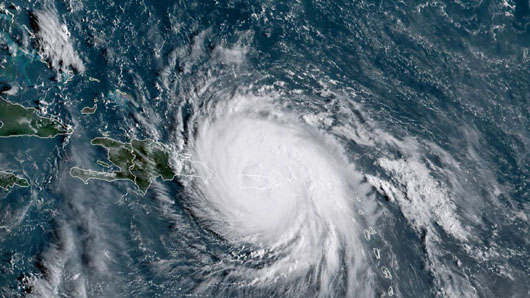by WorldTribune Staff, September 19, 2018
The source behind the Puerto Rico government’s claim that nearly 3,000 people died as a result of Hurricane Maria has received funding from leftist billionaire George Soros.
Puerto Rico’s government had initially said 64 people died as a result of the hurricane.
 The Milken Institute School of Public Health at George Washington University (GWU), which was contracted by Puerto Rico to investigate the death toll, released a report in late August projecting the death toll from the hurricane to be 2,975.
The Milken Institute School of Public Health at George Washington University (GWU), which was contracted by Puerto Rico to investigate the death toll, released a report in late August projecting the death toll from the hurricane to be 2,975.
President Donald Trump has been widely faulted in the major media and by Democrats for questioning the GWU study and what he said was the unprecedented and unproven method which created the numbers “like magic.”
Writing for LibertyNation.com on Sept. 16, Joe Schaeffer noted: “It should be no surprise that the usual suspects in the media would run with such poorly contrived ‘science’ and use it as yet another club to swing at their perpetual nemesis, President Trump. A closer look at the Milken Institute School of Public Health, however, reveals an outfit far removed from any plausible claim to be pursuing ‘objective’ research.”
The Milken institute’s annual Progress Report in 2016 and 2014 lists Soros’s Open Society Institute as one of its donors in its “Donor Acknowledgement” section.
The institute on its website notes that one of its professors, Jerome Paulson, “was a recipient of a Soros Advocacy Fellowship for Physicians from the Open Society Institute.”
In their study of Hurricane Maria, the Milken Institutes researchers “simply compared death figures from the post-hurricane months to the average number of deaths of the same timeframe during previous years, and found that there were more deaths than average following the storm,” Schaeffer wrote. “Attributing these deaths to Hurricane Maria has raised the storm’s official death toll by thousands, but does this supposition stand up to scrutiny? The study has been derided as poor science by critics who see it depending heavily on one variable and then using that thin string as an excuse to estimate increased deaths in the months after the hurricane that cannot be proven to be related to the storm.”
Page 3 of the report admits: “In the case of Puerto Rico we reviewed in- and out migration over the last decade and the net migration result was negative. The increase in out-migration has affected the population’s demographics, and the storm accelerated this trend.”
Schaeffer noted that “Younger people are leaving Puerto Rico. More left after the hurricane. The remaining older population would thus naturally seem to have a higher death rate. There is no way, therefore, that increased deaths after the hurricane can be solely pinpointed to the storm.”
Steve Haner, writing at the Virginia politics blog Bacon’s Rebellion, points out the ludicrousness of this projection: “Here’s my question, the itch not addressed in the report, that I saw: Who left? Who departed following the storm? Would the elderly, infirm and impoverished have been the ones to decamp to the mainland? Or would they have been the ones left behind? Doesn’t the shift in the baseline also at least in part explain this? The death rate really only jumped dramatically when you reduce the baseline population.”
Haner also explains how the study’s criticism of local authorities for not directly connecting post-hurricane deaths to the storm is a convenient way of justifying the increased death toll projection that the Milken Institute report itself wants to make:
“There are not 3,000 death certificates noting hurricane-related causes (loss of electricity, stress, poor transportation response) and the authors chide the local medical community for not being sufficiently exact in filling out their death certificates. So they are left with models and projections and estimates, which have translated into MSM-accepted Truth.”
Read Schaeffer’s full report here
Subscribe to Geostrategy-Direct __________ Support Free Press Foundation
